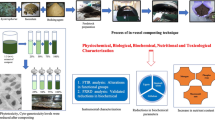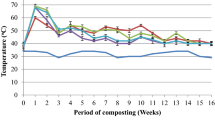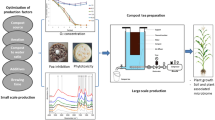Abstract
Ageratum conyzoides is an intrusive terrestrial waste spread worldwide and adversely impacting neighboring cultivated crops by replacing them. This study aims in producing a value-added and non-toxic product by biologically treating the plant blended with inoculum and bulking agent using a rotary drum composter (RDC). The composter was competent in increasing nutritional parameters such as nitrogen (50.1%), total phosphorous (18.4%), and potassium (26.1%) while decreasing lignin (42.4%), hemicellulose (39.1%), and cellulose (47.1%) in the final day (20th day) compared to the initial day. The spectroscopic analysis showed a significant increase in nutrients, decrease in cellulose content, and functional group variations in the final compost. The thermal and micrographic studies reveal the level of degradation. The phytotoxicity study showed a significant increase in germination index percentage (40.7%), root length (72.6%), shoot length (53.7%), and biomass (47.5%) in Vigna radiata and root length (67.2%) and biomass (46.2%) in Allium cepa exposed to final compost extract compared to A. conyzoides extract of same concentrations, whereas the cyto-genotoxicity assay showed a substantial increase in mitotic index and reduction in aberrant cell percentages in A. cepa root tips exposed to final compost extract compared to A. conyzoides extract. The Pearson correlation coefficient study revealed substantial correlation coefficients between biodegradation and nutritional factors. As a result, the A. conyzoides compost is safe for the environment and could be used as a soil conditioner in crop cultivation.
Graphical abstract







Similar content being viewed by others
References
Kauser H, Pal S, Haq I, Khwairakpam M (2020) Evaluation of rotary drum composting for the management of invasive weed Mikania micrantha Kunth and its toxicity assessment. Bioresour Technol 313:123678. https://doi.org/10.1016/j.biortech.2020.123678
Chengxu W, Mingxing Z, Xuhui C, Bo Q (2011) Review on allelopathy of exotic invasive plants. Procedia Eng 18:240–246. https://doi.org/10.1016/j.proeng.2011.11.038
Devi C, Khwairakpam M (2020) Feasibility of vermicomposting for the management of terrestrial weed Ageratum conyzoides using earthworm species Eisenia fetida. Environ Technol Innov 18:100696. https://doi.org/10.1016/j.eti.2020.100696
Leke WN, Brown JK, Ligthart ME et al (2012) Ageratum conyzoides: a host to a unique begomovirus disease complex in Cameroon. Virus Res 163:229–237. https://doi.org/10.1016/j.virusres.2011.09.039
Kapeua Ndacnou M, Pantaleon A, Saha Tchinda J et al (2020) Phytochemical study and anti-oomycete activity of Ageratum conyzoides Linnaeus. Ind Crops Prod 153:112589. https://doi.org/10.1016/j.indcrop.2020.112589
Kong C, Hu F, Xu X et al (2004) Allelopathic plants. Ageratum conyzoides L. Allelopath J 14:1–12
Kalamdhad AS, Singh YK, Ali M et al (2009) Rotary drum composting of vegetable waste and tree leaves. Bioresour Technol 100:6442–6450. https://doi.org/10.1016/j.biortech.2009.07.030
Wang K, Li X, He C et al (2014) Transformation of dissolved organic matters in swine, cow and chicken manures during composting. Bioresour Technol 168:222–228. https://doi.org/10.1016/j.biortech.2014.03.129
Hazarika J, Ghosh U, Kalamdhad AS et al (2017) Transformation of elemental toxic metals into immobile fractions in paper mill sludge through rotary drum composting. Ecol Eng 101:185–192. https://doi.org/10.1016/j.ecoleng.2017.02.005
Jain MS, Kalamdhad AS (2018) Efficacy of batch mode rotary drum composter for management of aquatic weed (Hydrilla verticillata (L.f.) Royle). J Environ Manage 221:20–27. https://doi.org/10.1016/j.jenvman.2018.05.055
Rich N, Bharti A, Kumar S (2018) Effect of bulking agents and cow dung as inoculant on vegetable waste compost quality. Bioresour Technol 252:83–90. https://doi.org/10.1016/j.biortech.2017.12.080
Sharma D, Yadav KD, Kumar S (2018) Role of sawdust and cow dung on compost maturity during rotary drum composting of flower waste. Bioresour Technol 264:285–289. https://doi.org/10.1016/j.biortech.2018.05.091
Maturi KC, Banerjee A, Kalamdhad AS (2021) Assessing mobility and chemical speciation of heavy metals during rotary drum composting of Ageratum conyzoides. Environ Technol Innov 24:101871. https://doi.org/10.1016/j.eti.2021.101871
Haq I, Kalamdhad AS (2021) Phytotoxicity and cyto-genotoxicity evaluation of organic and inorganic pollutants containing petroleum refinery wastewater using plant bioassay. Environ Technol Innov 23:101651. https://doi.org/10.1016/j.eti.2021.101651
Loubna EF, Hafidi M, Silvestre J et al (2015) Efficiency of co-composting process to remove genotoxicity from sewage sludge contaminated with hexavalent chromium. Ecol Eng 82:355–360. https://doi.org/10.1016/j.ecoleng.2015.05.022
ASTM D2974 (2020) Standard test methods for determining the water (moisture) content, ash content, and organic material of peat and other organic soils. ASTM International, West Conshohocken, PA, PA
APHA (2012) Standard methods for the examination of water and wastewater, 22nd ed. American Public Health Association, Washington D.C
Hazarika J, Khwairakpam M (2018) Evaluation of biodegradation feasibility through rotary drum composting recalcitrant primary paper mill sludge. Waste Manag 76:275–283. https://doi.org/10.1016/j.wasman.2018.03.044
Singh WR, Kalamdhad AS, Singh J (2016) The preferential composting of water fern and a reduction of the mobility of potential toxic elements in a rotary drum reactor. Process Saf Environ Prot 102:485–494. https://doi.org/10.1016/j.psep.2016.05.002
Varma SV, Nashine S, Sastri CV, Kalamdhad AS (2017) Influence of carbide sludge on microbial diversity and degradation of lignocellulose during in-vessel composting of agricultural waste. Ecol Eng 101:155–161. https://doi.org/10.1016/j.ecoleng.2017.01.022
Updegraff DM (1969) Semimicro determination of cellulose inbiological materials. Anal Biochem 32:420–424. https://doi.org/10.1016/S0003-2697(69)80009-6
Haq I, Kumar S, Raj A et al (2017) Genotoxicity assessment of pulp and paper mill effluent before and after bacterial degradation using Allium cepa test. Chemosphere 169:642–650. https://doi.org/10.1016/j.chemosphere.2016.11.101
Gurmessa B, Cocco S, Ashworth AJ et al (2021) Post-digestate composting benefits and the role of enzyme activity to predict trace element immobilization and compost maturity. Bioresour Technol 338:125550. https://doi.org/10.1016/j.biortech.2021.125550
Smith BAM, Eudoxie G, Stein R et al (2020) Effect of neem leaf inclusion rates on compost physico-chemical, thermal and spectroscopic stability. Waste Manag 114:136–147. https://doi.org/10.1016/j.wasman.2020.06.026
Jain MS, Paul S, Kalamdhad AS (2020) Kinetics and physics during composting of various organic wastes: statistical approach to interpret compost application feasibility. J Clean Prod 255:120324. https://doi.org/10.1016/j.jclepro.2020.120324
Biotreat NFBC (2003) Interpretation of Results Report. Cork, Ireland
Pramanik P, Ghosh GK, Ghosal PK, Banik P (2007) Changes in organic—C, N, P and K and enzyme activities in vermicompost of biodegradable organic wastes under liming and microbial inoculants. Bioresour Technol 98:2485–2494. https://doi.org/10.1016/j.biortech.2006.09.017
Hemati A, Aliasgharzad N, Khakvar R et al (2022) Bioaugmentation of thermophilic lignocellulose degrading bacteria accelerate the composting process of lignocellulosic materials. Biomass Convers Biorefinery. https://doi.org/10.1007/s13399-021-02238-7
Pardo RNC, Rojas GMA, Florez LM (2021) Thermal analysis of the physicochemical properties of organic waste to application in the compost process. Biomass Convers Biorefinery. https://doi.org/10.1007/s13399-021-01786-2
Yang F, Li Y, Han Y et al (2019) Performance of mature compost to control gaseous emissions in kitchen waste composting. Sci Total Environ 657:262–269. https://doi.org/10.1016/j.scitotenv.2018.12.030
Kumar Singh Y, Kalamdhad AS, Ali M, Kazmi AA (2009) Maturation of primary stabilized compost from rotary drum composter. Resour Conserv Recycl 53:386–392. https://doi.org/10.1016/j.resconrec.2009.02.004
Kalamdhad AS, Pasha M, Kazmi AA (2008) Stability evaluation of compost by respiration techniques in a rotary drum composter. Resour Conserv Recycl 52:829–834. https://doi.org/10.1016/j.resconrec.2007.12.003
Rai R, Suthar S (2020) Composting of toxic weed Parthenium hysterophorus: nutrient changes, the fate of faecal coliforms, and biopesticide property assessment. Bioresour Technol 311:123523. https://doi.org/10.1016/j.biortech.2020.123523
Jurado M, López MJ, Suárez-Estrella F et al (2014) Exploiting composting biodiversity: study of the persistent and biotechnologically relevant microorganisms from lignocellulose-based composting. Bioresour Technol 162:283–293. https://doi.org/10.1016/j.biortech.2014.03.145
Caceres R, Malinska K, Marfa O (2018) Nitrification within composting: a review. Waste Manag 72:119–137. https://doi.org/10.1016/j.wasman.2017.10.049
Galvez-Sola L, Morales J, Mayoral AM et al (2010) Estimation of phosphorus content and dynamics during composting: use of near infrared spectroscopy. Chemosphere 78:13–21. https://doi.org/10.1016/j.chemosphere.2009.09.059
Mishra SK, Yadav KD (2021) Disposal of garden waste using food waste inoculant in rotary drums and their ranking using analytical hierarchy process. Bioresour Technol Rep 15:100710. https://doi.org/10.1016/j.biteb.2021.100710
Weber J, Karczewska A, Drozd J et al (2007) Agricultural and ecological aspects of a sandy soil as affected by the application of municipal solid waste composts. Soil Biol Biochem 39:1294–1302. https://doi.org/10.1016/j.soilbio.2006.12.005
CPHEEO (2000) Manual on municipal solid waste management. Central Public Health and Environmental Engineering Organisation, Ministry of urban development, Government of India
Biyada S, Merzouki M, Elkarrach K, Benlemlih M (2020) Spectroscopic characterization of organic matter transformation during composting of textile solid waste using UV–Visible spectroscopy, infrared spectroscopy and X-ray diffraction (XRD). Microchem J 159:105314. https://doi.org/10.1016/j.microc.2020.105314
Paul S, Kauser H, Jain MS et al (2020) Biogenic stabilization and heavy metal immobilization during vermicomposting of vegetable waste with biochar amendment. J Hazard Mater 390:121366. https://doi.org/10.1016/j.jhazmat.2019.121366
Zahra EOF, El Fels L, Lemee L et al (2015) Evaluation of lignocelullose compost stability and maturity using spectroscopic (FTIR) and thermal (TGA/TDA) analysis. Ecol Eng 75:217–222. https://doi.org/10.1016/j.ecoleng.2014.12.004
Zhang T, Wu X, Shaheen SM et al (2021) Effects of microorganism-mediated inoculants on humification processes and phosphorus dynamics during the aerobic composting of swine manure. J Hazard Mater 416:125738. https://doi.org/10.1016/j.jhazmat.2021.125738
Hajji L, Boukir A, Assouik J et al (2015) Conservation of Moroccan manuscript papers aged 150, 200 and 800years. Analysis by infrared spectroscopy (ATR-FTIR), X-ray diffraction (XRD), and scanning electron microscopy energy dispersive spectrometry (SEM–EDS). Spectrochim Acta Part A Mol Biomol Spectrosc 136:1038–1046. https://doi.org/10.1016/j.saa.2014.09.127
Ho CP, Yuan ST, Jien SH, Hseu ZY (2010) Elucidating the process of co-composting of biosolids and spent activated clay. Bioresour Technol 101:8280–8286. https://doi.org/10.1016/j.biortech.2010.06.058
Hajji L, Boukir A, Assouik J et al (2016) Artificial aging paper to assess long-term effects of conservative treatment. Monitoring by infrared spectroscopy (ATR-FTIR), X-ray diffraction (XRD), and energy dispersive X-ray fluorescence (EDXRF). Microchem J 124:646–656. https://doi.org/10.1016/j.microc.2015.10.015
Fernández JM, Plaza C, Polo A, Plante AF (2012) Use of thermal analysis techniques (TG–DSC) for the characterization of diverse organic municipal waste streams to predict biological stability prior to land application. Waste Manag 32:158–164. https://doi.org/10.1016/j.wasman.2011.08.011
Sharma A, Ganguly R, Gupta AK (2019) Spectral characterization and quality assessment of organic compost for agricultural purposes. Int J Recycl Org Waste Agric 8:197–213. https://doi.org/10.1007/s40093-018-0233-7
El Fels L, Hafidi M, Ouhdouch Y (2016) Artemia salina as a new index for assessment of acute cytotoxicity during co-composting of sewage sludge and lignocellulose waste. Waste Manag 50:194–200. https://doi.org/10.1016/j.wasman.2016.02.002
Yadav A, Raj A, Purchase D et al (2019) Phytotoxicity, cytotoxicity and genotoxicity evaluation of organic and inorganic pollutants rich tannery wastewater from a Common Effluent Treatment Plant (CETP) in Unnao district, India using Vigna radiata and Allium cepa. Chemosphere 224:324–332. https://doi.org/10.1016/j.chemosphere.2019.02.124
Mazumder P, PM A, Jyoti, et al (2021) Enhancement of soil physico-chemical properties post compost application: optimization using response surface methodology comprehending central composite design. J Environ Manage 289:112461. https://doi.org/10.1016/j.jenvman.2021.112461
Li Y, Sun B, Deng T et al (2021) Safety and efficiency of sewage sludge and garden waste compost as a soil amendment based on the field application in woodland. Ecotoxicol Environ Saf 222:112497. https://doi.org/10.1016/j.ecoenv.2021.112497
Acknowledgements
The authors are grateful to the Department of Civil Engineering, Central Instrumentation Facility, and Centre for the Environment at the Indian Institute of Technology Guwahati, India, for providing workspace and carrying out PXRD, FESEM, TGA/DTA, and FTIR analysis. The authors are very much grateful to anonymous reviewers for providing valuable comments that helped in improving the quality of the manuscript substantially.
Funding
The authors recognize the Department of Science and Technology, Government of India, New Delhi, for financial support (File No. DST/TDT/WMT/2017/153 (G)).
Author information
Authors and Affiliations
Contributions
KCM: data curation, conceptualization, writing-original draft, methodology, software
IH: methodology, writing—review and editing
ASK: supervision, conceptualization, writing—review and editing
Corresponding author
Ethics declarations
Competing interests
The authors declare no competing interests.
Additional information
Publisher's note
Springer Nature remains neutral with regard to jurisdictional claims in published maps and institutional affiliations.
Highlights
• Bioconversion of toxic terrestrial weed into a nutrient-rich compost.
• The nitrogen content was increased by 50.1% in the 20 days of composting.
• FTIR analysis shown a rise in ratio of aromatic to aliphatic compounds.
• Mass reductions and substrate deformations were assessed by TGA and FESEM analysis.
• Biocomposting lead to reduction of phytotoxicity and cyto-genotoxicity.
Supplementary Information
Below is the link to the electronic supplementary material.
Rights and permissions
About this article
Cite this article
Maturi, K.C., Haq, I. & Kalamdhad, A.S. Insights into the bioconversion of Ageratum conyzoides into a nutrient-rich compost and its toxicity assessment: nutritional and quality assessment through instrumental analysis. Biomass Conv. Bioref. 14, 3879–3895 (2024). https://doi.org/10.1007/s13399-022-02532-y
Received:
Revised:
Accepted:
Published:
Issue Date:
DOI: https://doi.org/10.1007/s13399-022-02532-y




